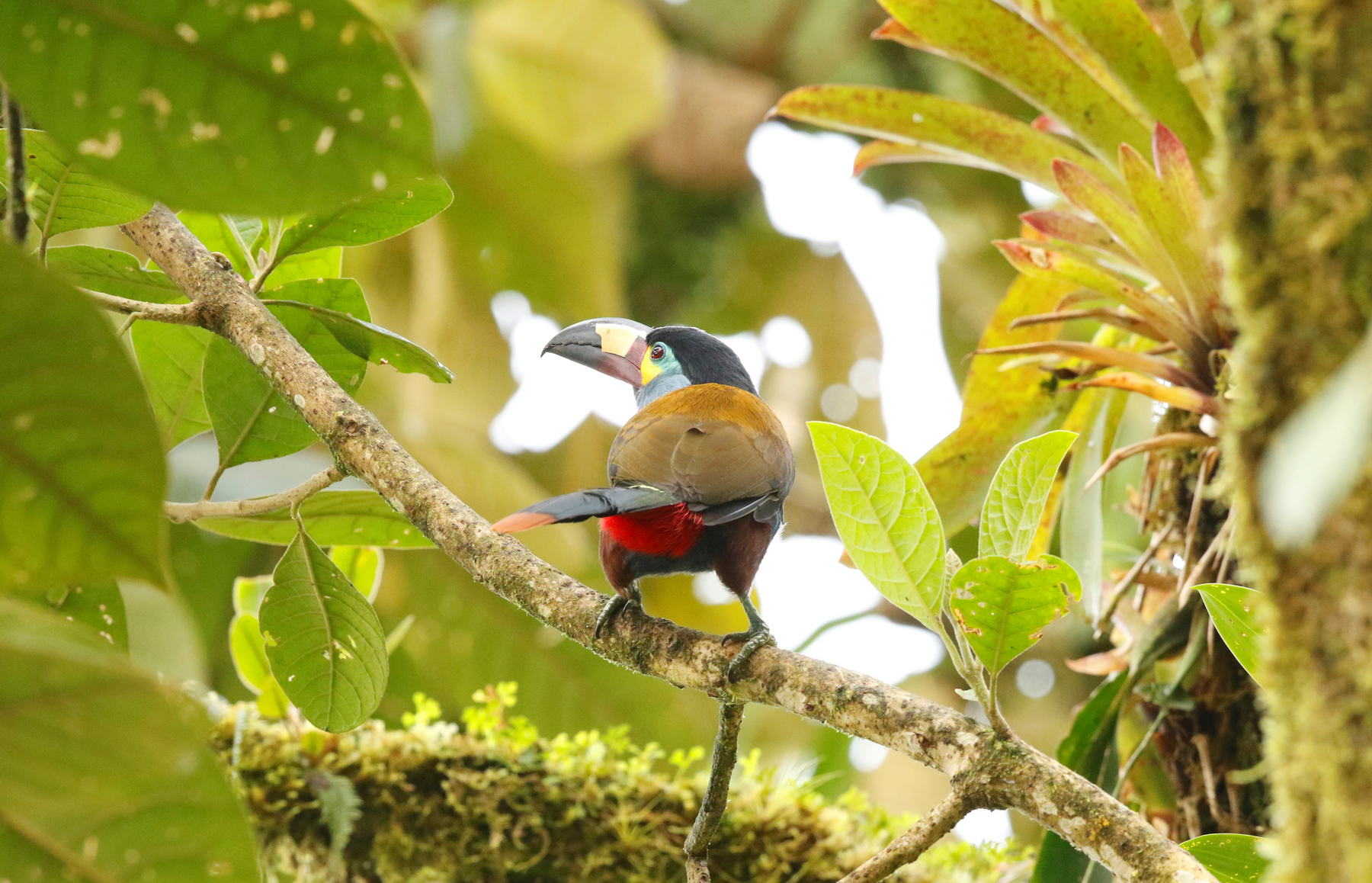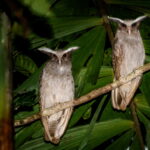This is a Private Tour
14 days from £4,614 / $5,537 (Single Supplement £367 / $440) Amazon extension 5-days from £1,708 / $2,049
A birding journey starting in Quito and driving west through the Andes, to the birding paradise of Mindo. Spend three full days exploring the region, spotting hummingbirds, antpittas, umbrellabirds and the inimitable cock-of-the rock. Travel back to the highlands. Visit the volcano of Antisana and see condors. Then head to the eastern lowlands for sub-tropical species and the headwaters of the Amazon.
Tour Includes
Private transportation,
Bilingual naturalist guide (specialized in birdwatching)
Accommodation based on double room
Meals as described on the itinerary
Entrance fees to reserves
Tour Excludes
International Flights
Alcoholic drinks
Tips and personal expenses
Insurance
Highlights
Explore Mindo Ecuador’s biodiversity hotspot
Get up close to hummingbirds and antpittas
Watch the iconic cock-of-the-rock and umbrellabirds
High Andes species like condors
Tropical toucans and parrots
To book this tour or start creating your own tailor made itinerary call us on: 0207 407 1478 (UK) or contact us.
Tour Code(s):
BECBEW14D
Pricing
14-days from £4,614 / $5,537 (Single Supplement £367 / $440)
Amazon extension 5-days from £1,708 / $2,049 (Single Supplement £777 / $932)
The Trip
Day 1: Quito – Arrive Quito / Hotel Ikala
Day 2: Mindo – Cross the western Andes to Mindo / Sachatamia lodge
Day 3: Mindo – Vist Mashpi Amagusa reserve & Los Tayos / Sachatamia lodge
Day 4: Mindo – Milpe reserve & umbrellabirds / Sachatamia lodge
Day 5: Mindo – Rio Silanche tropical lowlands& San Tadeo / Sachatamia lodge
Day 6: Quito – Paz de las Aves refuge then to Quito / San José de Puembo
Day 7: Guango – Visit the paramo of Antisana volcano / Guango lodge
Day 8: San Isidro – Cross the eastern slopes of the Andes / San Isidro lodge
Day 9: San Isidro – Visit eastern cloud forest / San Isidro lodge
Day 10: San Isidro – Visit eastern cloud forest / San Isidro lodge
Day 11: Wildsumaco – Take the Loreto road southeast / Wildsumaco
Day 12: Wildsumaco – Explore the south eastern foothills / Wildsumaco
Day 13: Quito – Travel back up the Andes to Quito / San José de Puembo
Day 14: Flight – Transfer to the airport for flight home
Amazon Extension to Sacha Lodge
Day 13: Coca – Amazon – Transfer to Coca, canoe to lodge / Sacha Lodge
Day 14: Amazon – Explore Amazon / Sacha Lodge
Day 15: Amazon – Explore Amazon / Sacha Lodge
Day 16: Amazon – Transfer to Coca, fly to Quito / San Jose de Puembo
Day 17: Flight – Transfer to airport, fly home.
THE LONG ITINERARY
Day 1: Quito – Ecuador
On your arrival to Ecuador our guide will be waiting for you to meet and transfer you to your hotel to overnight.
Day 2: Tandayapa – Mindo
Early departure to the northwest of Quito crossing the western slopes of the Andes range heading towards Tandayapa valley. On route visit Yanacocha reserve a high-altitude cloud forest. The reserve protects Polylepis Forest, home to many bird species like the famous Black-breasted Puffleg, sword billed hummingbird, great saphirewing, purple backed thornbill, rufous antpitta, barred fruiteater. Continue down the valley and see other species such as bar bellied woodpecker, masked flowerpiercer, glossy flowerpiercer, shinning sunbeam, great saphirewing, barred fruiteater, hooded and scarlet-bellied mountain-tanagers, giant conebill, pearled treerunner.
(B/L/D)
Day 3: Mindo – Mashpi Area
After breakfast drive you to Mashpi – Amagusa Reserve, this cloud forest is rich in plants from ferns and bromeliads to myriad orchids. A staggering 500 species of birds (including some 36 endemics) as well as small mammals. It is famous for its impressive collection of Choco endemic bird species. Depart to El Chontal to look for the famous Los Tayos Cave, a deep, dark ravine where home to mysterious Oilbirds Steatornis caripensis; en-route enjoy a picnic lunch. Late afternoon return to Sachatamia Lodge.
(B/L/D)
Day 4: Mindo – Milpe Reserve
Early in the morning you will depart to Los Bancos to spot for the incredible Umbrella bird. Arrive at Luis Agila’s property where it is possible to find this vulnerable species. It’s an amazing experience when you suddenly see a group of Umbrella birds flying from one tree to another looking for insects or fruit. With luck, see the long wattle of a male getting inflated, it’s something unique.
Visit to Milpe Bird Sanctuary, an important bird area, of 62 hectares (155 acres). The altitude ranges from 1020-1150m (3350-3770 ft) and includes two small rivers and forested valley. Many local birders consider to be one of the finest sites in all of Ecuador. Here 247 species are found including many Choco endemic species: plumbeous forest-falcon, moss-backed tanager, glistening-green tanager, chocó trogon, choco toucan, club-winged manakin, indigo-crowned quail-dove, double-banded greytail, fulvous-vented euphonia, emerald and scarlet-and-white tanagers, the near-threatened blue-whiskered tanager and long-wattled umbrellabird. Return to Sachatamia Lodge.
(B/L/D)
Day 5: Silanche – San Tadeo
Head to Rio Silanche a tropical lowland reserve of with incredible species diversity. The observation tower gives an eye-to-eye view of mixed flocks. This site is in the foothills at 300-350m, one of the last remaining accessible forest remnants found in this key area. It is home to many important Choco and Tumbesian endemic bird species, including dusky pigeon, purple-chested hummingbird, little woodstar, choco trogon, double-banded graytail, stub-tailed antbird, slate-throated gnatcatcher, scarlet-breasted dacnis, scarlet-and-white tanager, blue-whiskered tanager, gray and gold tanager, rose face parrot, blue headed parrot, marron tailed parakeet, white bearded manakin, scarlet thighed dacnis, chestnut mandibled toucan, black headed tody flycatcher, slaty capped shrike-vireo, among many others. Enjoy of a picnic lunch surrounded by amazing nature.
Next stop at Mirador del Río Blanco, a place that offers an incredible view of the valley and where you can find different species of tanagers and some hummingbirds such as the tiny green thorn tail and the beautiful green-crowned brilliant. Then arrive to San Tadeo where a local family set up a hide with multiple feeders, get amazing photos of different tanagers, toucanets, barbets. Return to Sachatamia. (B/L/D)
Day 6: The Cock of the Rock
Early in the morning, after a coffee, visit the famous Paz de las Aves Refuge with the cock of the rock lek. During the breeding season, the males create a unique sound and fly like acrobats to impress a female to mate. Other specialties in the reserve are four species of antpittas, the giant antpitta, the mustached antpitta, ochre bellied, and the yellow breasted antpitta. Visit the feeding station to see black chinned and blue winged mountain tanagers, toucan barbet, dusky piha, sickle winged guan, crimsom-rumped toucanet, etc.
Return to the main house for a typical breakfast and find an ocellated tapaculo being fed with worms, yellow vented woodpecker, powerful woodpecker, crimson mantled woodpecker, orange breasted fruiteater etc. Then return to Sachatamia Lodge for lunch and in the afternoon, return to Quito. Stay at San José de Puembo, in a sunny valley. The hotel is established in a restored colonial building, which dates to the 18th Century. (B/L/D)
Day 7: Antisana – Guango
Travel to Antisana Ecological Reserve, high in the Andes. At the Mica Lake observe silvery grebe, andean teal, andean ruddy duck, yellow-billed pintail, andean coot, and as well as many land birds such as aplomado falcon, Andean gull, Andean lapwing and carunculated caracara. There is a good chance to see the majestic Andean condor and other species like black-chested buzzard-eagle and variable hawk, black faced ibis, paramo ground tyrant, paramo pipit, sedge wren, Bairds sandpiper, cinereous harrier, bar-winged and stout-billed cinclodes, black-faced ibis, shining sunbeam, red- rumped bush-tyrant, paramo pipit, giant conebill, and spectacled whitestart.
Depart to Guango Lodge through the Papallacta region. This area has well conserved patches of Polylepis forest and it is an excellent place to observe high mountain bird species. The 4000m high paramo species like the variable hawk, many-striped canastero, tawny antpitta and Andean condor. Other species expected in this area are the sword-billed hummingbird, great sapphire-wing, scarlet-bellied mountain-tanager, torrent duck, torrent tyrannulet and the superb white-capped dipper. Guango Lodge lies at a higher elevation of about 2,700m on the eastern slope. This area is humid temperate forest, with stunted trees, cooler climate. Stay at Guango Lodge.
(B/L/D)
Day 8: Papallacta – San Isidro
Early hike looking for species like Andean guan, plushcap, slaty finch, gray breasted mountain toucan, pale-naped brush finch, gray hooded bush tanager, hooded mountain tanager, pearl tree runner, mountain avocet bill, tourmaline sun angel, torrent duck, white capped dipper etc. After lunch continue to San Isidro Lodge to seek out specialties such as black-chested fruiteater, long-tailed antbird, white belied antpitta, San Isidro’s owl, chestnut breasted coronet, long tailed sylph, barred ant thrush and the little-known Peruvian antpitta. In the afternoon discover more bird species. After dinner we will have a nocturnal walk looking for nightjars and owls. San Isidro Lodge lies at about 2,000m (6,800 ft.) in a zone still mostly blanketed by extensive humid forest. This means agreeable temperatures, exciting birds, and a diversity of wildlife.
(B/L/D)
Days 9 & 10: San Isidro Lodge
Enjoy two days at San Isidro lodge and its surroundings, some of the species include: montane and olive-backed woodcreepers, golden-crowned flycatcher, rufous-crowned tody-flycatcher, black-billed peppershrike, Inca jay, bluish flower piercer and subtropical cacique. Plus, antpitta feeders, where you will likely see white-bellied antpitta only feet away, and maybe even the very rare Peruvian antpitta. Others include the black-chested fruiteater, long-tailed antbird, white belied antpitta, San Isidro’s owl, chestnut breasted coronet, long tailed sylph, barred ant thrush and others. At dusk you can try to spot near the lodge night birds like the Andean potoo, rufous-bellied nighthawk (almost every dawn and dusk around the cottages) and rufous-banded and mottled owls. (B/L/D)
Day 11: Wildsumaco
Depart to Wildsumaco Lodge, via the Loreto-Coca Road, famous for its birding opportunities. Some notable target birds along the upper Loreto Road include dark – breasted spinetail, ash-browed spinetail, montane foliage-gleaner, lined antshrike, foothill antwren, olivaceous greenlet, yellow-whiskered chlorospingus, and bronze-green euphonia. Then you will visit Narupa reserve which protects a large block of eastern Andean foothill forest. Narupa has a growing list of birds that currently includes over 300 species. Five globally threatened species have been recorded, including its flagship species, the Cerulean Warbler, a long-distance migrant that breeds in eastern North America and spends the boreal winter in northwestern South America.
In the afternoon visit the Cordillera de Los Huacamayos and walk through one of the specialized birdwatching trails. Here it is possible to see many different species and look for the black-billed mountain-toucan, white-bellied antpitta, Spillmans tapaculo, bicoloured antvireo, greater scythebill and the very local white-rimmed brush-finch among others. Late afternoon you will arrive at Wildsumaco lodge. The lodge is a comfortable place with ten rooms, each with private bathroom with hot and cold water. There are nice social areas, a restaurant, bar, and a cozy porch from where you can admire the birds and the magnificent view.
(B/L/D)
Day 12: Wildsumaco
Wildsumaco lodge is located between the Andean Foothills and the Amazon, Sumaco holds one of the richest avifauna in the world. A wonderful mix of cloud forest species, foothill and typically Amazonian birds. Plus, a myriad of other animals. Many of the birds here are rare, endangered, or very difficult to see elsewhere. Some of the species include gray-tailed piha, blue-rumped manakin, coppery chested jacamar, military macaw, buff breasted tody, blackish rail, tropical screech owl, black banded crake, and chestnut-crowned gnateater. The short-tailed ant thrush and wing-banded wren often sing, while more uncommon species like gray-throated leaftosser and plain-backed antpitta are seen occasionally. The very rare yellow-throated spadebill has a territory along the piha trail and the endangered military macaw or rare spot-winged parrotlet might fly by, or black hawk-eagle soar overhead.
(B/L/D)
Day 13: Quito
Take a last opportunity to enjoy of this amazing place, then you will return to Quito, 4 hours by car, possible stop on the way to search for orange breasted falcon and cliff flycatcher. Picnic lunch on route and late afternoon arrive to the hotel located close to the Quito’s airport for dinner and stay overnight. San José de Puembo.
(B/L/D)
Day 14: Flight home
After a long list of birds on this unforgettable expedition in Ecuador you will be transferred to the airport to catch your international flight home.
Amazon Extension to Sacha Lodge
Day 13: Coca – Sacha Lodge
Embark on a captivating journey as you depart from Quito’s airport at 11h00. A 30-minute flight will take you over the majestic Andes Mountains, to the bustling oil town of Coca. This lies in the heart of the Amazon Basin. Enjoy a quick lunch at Sacha’s private house. Then board one of Sacha’s private canoes at the town docks. Embark on a scenic 2-hour journey down the river, immersing yourself in the beauty of the Amazon. Then you reach Sacha Lodge’s dock. From here, take a 30-minute boardwalk to the lake. Local staff will paddle you to the lodge.
Once you arrive at Sacha Lodge around 15h30 pm, you could take a refreshing swim in the black water lake or rest in a hammock. The ox-bow Lake Pilchicocha is home to a variety of fish and animals. As the sun sets, head to the mini tower for an to observe several species of birds that are common around the lodge. Later, visit the butterfly house with your knowledgeable naturalist guide. Marvel at the vibrant colours of different butterfly species. After dinner, join your guide for a captivating night walk through the rainforest. You can see nocturnal animals that only appear under the cover of darkness. Alternatively, take a peaceful canoe ride on the lake. You can observe the spectacled and black caimans with their mesmerizing orange eyes. (L/D)
Day 14: Sacha Lodge
Begin your morning activity between 6h00 and 7h00, setting off on the Liana Chica trail. This trail will lead you to the awe-inspiring canopy walkway. This offers spectacular views of the rainforest canopy and its vibrant birdlife. Sacha’s canopy walk is a self-standing suspension walkway, one of the few in the world. It provides an up-close and personal view of the tropical rainforest’s wonders. With observation decks every 12 metres, the walkway gives breathtaking views from a height of 36 metres and a length of 275 metres. After the canopy walk, continue your journey on the Liana Grande trail. Accompanied by indigenous guides, explore the terra firma and igapo forest habitats. You will discover various species of medicinal plants used by indigenous cultures for centuries. The trail will then lead you to the Higueron trail, through pristine primary forest adorned with towering kapok and fig trees.
Following a tasty lunch, choose between a walk along the Rio Napo or a more challenging hike on the Leoncillo trail. There you may spot the dusky titi monkey. Both trails will guide you back to the main boardwalk, for a final walk and canoe paddle back to the lodge. (B/L/D)
Day 15: Sacha Lodge
Don’t miss the chance to witness the spectacle of four different species of parrots at the same time. Embark on a 30-minute motorized canoe ride down the Napo River to Yasuni National Park’s parrot lick. Departing from Sacha at six in the morning, you will arrive at the lick around 7h30. This gives ample time to observe the parrots as they consume clay. They do this to neutralize the toxins from their diet of fruits and leaves. Return to the lodge around 11h00, where you can relax before lunch. Visit the butterfly house once again to capture the beauty of these colourful creatures through your lens.
In the afternoon, explore the Pantano trail, through various rainforest habitats, as well as flooded areas and swamps. This trail offers an excellent opportunity to encounter monkeys and birds. Your guides will provide insights into the jungle’s wonders, leaving you with lasting memories of the rainforest. (B/L/D)
Day 16: Sacha – to Quito
Enjoy a final breakfast at Sacha Lodge before embarking on an easy walk along the boardwalk, where you can observe monkeys one last time. Leave from the lodge at 7h30am, heading back to Coca by motorized canoe. At Coca airport, Sacha employees will assist you with your plane tickets and bid you a fond farewell. Scheduled arrival at Quito’s airport is at 12h30pm. Check-in for Coca – Quito flight. Once in Quito, you will be transferred to a hotel in the historic Centre (or a country Inn). (B)
Day 17: Flight home
- All itineraries are subject to change based on local conditions, weather and logistics
- A special birding itinerary at Sacha can be provided upon request, led by a bilingual birding guide.
- We recommend adding another night in the Amazon for keen birders.
Gallery
Click or tap on the pictures below to see the photo gallery:
INSPIRED? EACH JOURNEY WE CREATE IS UNIQUE AND DESIGNED ENTIRELY AROUND YOU. FILL OUT YOUR DETAILS HERE TO GET STARTED...













